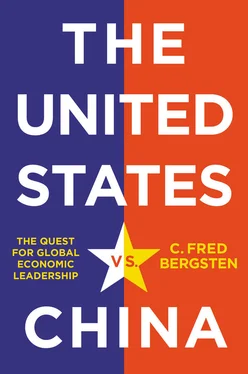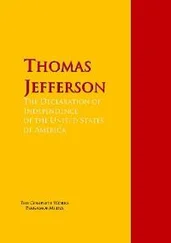Or China and the United States could resolve to work together, at least on issues of sufficient importance to sustain the system, to provide effective co-leadership through what I will call conditional competitive cooperation . The strong form of this alternative would be a G-2 through which the two economic superpowers would exercise joint leadership of the world economy, radiating out through concentric circles of other countries (G-3/4, G-7/20, the formal multilateral institutions), as outlined in chapter 9.
Before addressing these alternative systemic futures, we need to assess the record of the past and current international economic order, and the role that leadership or lack thereof has played in its successes and failures. The liberal order has been a centerpiece of the global peace and prosperity that has prevailed over the 75-year period since the end of the Second World War. Along with the military power of the United States and its allies that secured the peace, it has enabled an era of economic growth and poverty reduction that is unprecedented in history. This has in turn supported sufficient political stability, both within and across countries, to prevent the great-power conflicts that devastated the previous thirty years (and much of the previous centuries). The economic system played an important role in ending the Cold War (Ikenberry 2008).
The economic order was created in 1944 explicitly to avoid a replication of the chaos of the interwar period, whose competitive currency devaluations and trade wars (due, importantly, to the Kindleberger trap) played a central role in bringing on the Great Depression and the Second World War. It rested on several key principles. The most fundamental were the avoidance of beggar-thy-neighbor policies, the primacy of markets, the rule of law, and cooperative institutions to support them. The economics of the system were guided largely by the price mechanism and private enterprises, with extensive trade and (increasingly) investment liberalization among at least the major countries. Constitutions and legal systems provided assurances that these economic principles would be implemented in practice, generating confidence that the order would be sustainable and successful. A wide range of supportive international institutions were put in place and nurtured to maintain and further build that confidence. Democracy reinforced the economic and legal foundations in most – though not all – countries. It was no coincidence that these principles and their implementation corresponded closely with values held, if not always practiced perfectly, by the United States and its main allies.
The United States has a vital national interest in the stability and prosperity of the world economy, for both security and economic reasons. Maintenance of the global economic order has been a centerpiece of its foreign policy, and indeed national security policy, since the Second World War. The international order was dominated by the United States and its friends and allies, initially in Western Europe (also Canada and Australia) but increasingly in Asia as well (most notably Japan and, later, South Korea).
Much of the system’s rules and governance was carried out through multilateral institutions. Some were formal and highly legalized structures – notably, the Bretton Woods twins (the IMF and the World Bank) and the General Agreement on Tariffs and Trade (GATT) / WTO. Some were informal but occasionally powerful, such as the “Gs” that provided the main steering mechanisms (now the G-20 and G-7). Some function at the regional level – most importantly, the European Union and the eurozone, but also other regional trading arrangements (NAFTA/USMCA, now CPTPP and RCEP, etc.) and the regional development banks. Most include both the United States and China, but a few exclude China (OECD, G-7, Paris Club) and a few exclude the United States (AIIB, BRI, NDB).
The system, of course, revealed many shortcomings. Some countries, and indeed whole regions (such as the Middle East and Africa), fared poorly for prolonged periods. Crises became increasingly frequent and severe. Income distribution has regressed within numerous countries, including the United States and China. Wages have been stagnant in some, including the United States. Domestic opposition to features of the system – most notably the backlash against globalization in the United States itself dating from the middle 1990s – arose on numerous occasions in numerous quarters.
The overall record, however, is a stunning success. Per capita incomes have risen six-fold over the postwar period. Across the globe, income is more equal than it has been in centuries (the Gini coefficient improved from 0.60 in 1990 to 0.47 in 2013, though it is still much too high) as poor people in China and other poor countries advanced rapidly. More than three dozen countries have graduated from developing to high-income or middle-income status. A billion people have escaped extreme poverty in the last two decades; the share of the global population living in extreme poverty fell from 40 percent in 1980 to less than 10 percent in 2015 (prior to the coronavirus pandemic). Far fewer people than ever go hungry; the share of the world’s population that is malnourished has fallen from 50 percent to 13 percent since the 1960s. Advances in technology have been breathtaking and occur at an accelerating pace.
Both the United States and China have benefited enormously from the postwar order. The US economy is $2 trillion richer per year as a result of the globalization of the past 75 years (Hufbauer and Lu 2017). Though it started late, entering the world economy only with its reforms of the late 1970s, China has been by far the greatest single beneficiary of the global system: its nominal economy grew by 37 times from 1978 to 2018, its average standard of living multiplied by a factor of 26, its share of the world economy rose from less than 2 percent to 16 percent, and its per capita incomes expanded from one fifth of the world average in 1949 to that average itself (Yang 2020).
The system also succeeded in heading off the risk of a second Great Depression in 2008–9. The contrast with the 1930s could not have been greater. Better national policies were of course a central reason, but so was international cooperation to avoid the trade barriers and competitive devaluations that were so devastating in the earlier period. Those outcomes, including the improved national policies, were fostered by international cooperation via the G-20 and through the IMF and WTO.
The system passed its most critical stress test with fairly flying colors (Drezner 2016). It can certainly be improved, but there can be no doubt that it is worth preserving. Ikenberry (2020) summarizes the verdict nicely: “Despite its faults, no other organizing principle currently under debate comes close to liberal internationalism in making the case for a decent and cooperative world order that encourages the enlightened pursuit of national interests.”
There can also be no doubt that China is challenging the existing order and will do so increasingly over the years and decades ahead. The official Chinese narrative is that its rise to its current and prospective global status is simply a restoration of the country’s historical position. China was the largest economy in the world, at least until 1750, or perhaps even 1850, when the Industrial Revolution enabled Great Britain and Europe, and the West more generally, to supersede it.
The “century of humiliation,” from the Opium Wars until the Communist revolution, deepened China’s demise and instilled a yearning for recovery (and even revenge) that infuses the country’s thinking today. President Xi Jinping importuned President Trump with the Treaty of Versailles, in which the victorious allies of the First World War gave a Chinese province occupied by defeated Germany to Japan, rather than back to China (Bolton 2020). At a minimum, China clearly wants to regain the respect, and preferably deference, that it received during the long era when the Middle Kingdom reigned supreme.
Читать дальше












